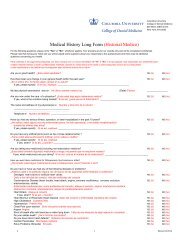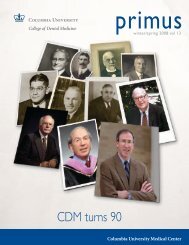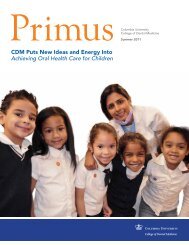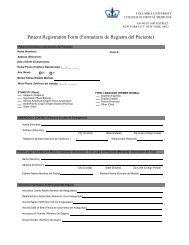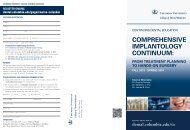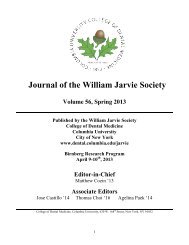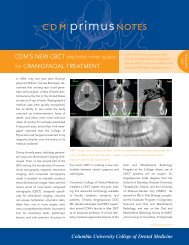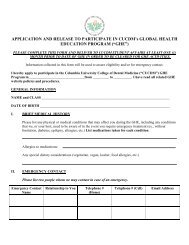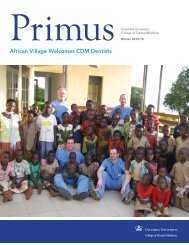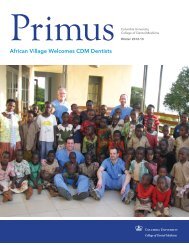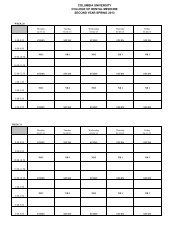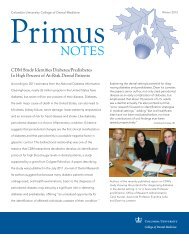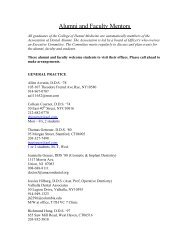Fall 2006 - College of Dental Medicine - Columbia University
Fall 2006 - College of Dental Medicine - Columbia University
Fall 2006 - College of Dental Medicine - Columbia University
Create successful ePaper yourself
Turn your PDF publications into a flip-book with our unique Google optimized e-Paper software.
PRIMUS notableQ. Dr. Kucine, you graduated at the top <strong>of</strong> your class from <strong>Columbia</strong>’sdental school; does that mean you wanted to be a dentist when you ALLAN J. KUCINE ‘82grew up?A. When I was growing up in Brooklyn, the guidelines for success usuallymeant being a doctor. I had good enough grades for medical school,but I noticed that my family dentist had a very nice life. He lived in awhite house with green shutters, had a wife who brought his lunch tothe <strong>of</strong>fice every day, and he took her on vacation to some warm islandevery year. So, I thought,“I could do that!”Q. So, why did you give up your successful private practice as an oraland maxill<strong>of</strong>acial surgeon in exchange for full-time academic and administrativepositions at Stony Brook <strong>University</strong>?A. I love my specialty -- and still treat patients at the <strong>University</strong> Hospitalat Stony Brook and the School <strong>of</strong> <strong>Dental</strong> <strong>Medicine</strong> Faculty Practice. ButI discovered I was happiest when teaching. Helping students fromdiverse backgrounds acquire knowledge and skills, and to develop aspr<strong>of</strong>essionals-- is exciting! It’s especially rewarding when one <strong>of</strong> themreturns later in life to say,“that was a great education.”Q. What makes a good teacher?A. Well, I had wonderful teachers in dental school: Irwin Mandel, SteveRoser, and Ed Cain, who, when I told him I was going to be an “oral surgeon,”said,“Remember, Kucine, we’re ALL surgeons!” Like them, I teachmy students to think through problems, not just to memorize answers.Every patient the student encounters <strong>of</strong>fers an opportunity to considerthe risk/benefit ratio for various treatments in determining the ultimatecourse <strong>of</strong> therapy.Q. Since coming to SUNY/Stony Brook’s School <strong>of</strong> <strong>Dental</strong> <strong>Medicine</strong> inthe early 1990s, you have held posts as Director <strong>of</strong> Pain Control,Assistant Dean for Postdoctoral Education, Associate Dean forCurriculum and Postdoctoral Programs, Associate Dean for AcademicAffairs, Associate Dean for Clinical Affairs, and both Vice Chairman andActing Chairman <strong>of</strong> the Department <strong>of</strong> Oral and Maxill<strong>of</strong>acial Surgery.Is there any other role you can fulfill there?A. In fact, I have taken on responsibility for Information Technology.Many schools still use paper records in their clinics, but Stony Brook<strong>University</strong> has “gone electronic” as intelligently as possible, developingsystems for assessment, quality assurance, and patient care. Our nextproject will be data mining, which may uncover significant, and possiblyunexpected, relationships among our demographic and treatment statistics.We also hope to have kiosks in our clinics soon, where patientscan enter information electronically.Q. You also just shepherded your school through an ADA site visit.How did it go?A. Wonderfully. We received no recommendations and a number <strong>of</strong>commendations; I’m very pleased.The Primus Notable feature appears regularly in CDM publications, focusing on a graduate <strong>of</strong> distinction who has maintained a close interest in the <strong>College</strong> throughout his or her career.



